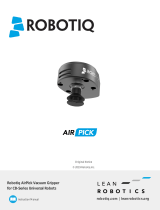Page is loading ...

QUICK START GUIDE
1. GET READY
X-990117-A
1. Complete the Machine Tending Solution Quick Start
Guide for installation on Universal Robots.
2. Put a part in the workholding.
3. Close the machine door.
4. Empty all grippers.
5. Identify gripper 1 (blank) and gripper 2 (part).
6. Set the corresponding gripper ID in the Installation
menu.
7. Rotate the Wrist #3 to 0° in joint position.
8. Set TCP/Payload using the TCP of gripper 1 as your
default TCP.
9. Create a new program.
10. Add a Machine Tending node to the program.
11. Tap on Configuration.
12. Select the options that reflect your set-up.
13. Tap Generate program.
2. WHAT TO EXPECT
• The Machine Tending program tree is divided in two
sections: Program and Macro List.
• Program defines the order in which the robot executes
each action (macro).
• Macro List is where the robot actions are programmed
and taught.
• The Gripper Close/Open nodes will have to be added
when prompt in the program tree (ex: At Part
Waypoint).
3. AT EACH MACRO
1. Open the macro under Macro List.
2. Open the node. Ignore the Smart Move node.
3. Refer to the pictograms for the gripper positions.
4. Grab the gripper you will be using based on the number
in the macro name (Ex: Pick_Blank_1).
5. Teach the approach and action points required for that
node.
6. Use the Test button (optional) to test the node.
7. Keep the active part in the gripper.
8. Repeat for all nodes.
For programmation of Machine Tending
Solution on e-Series Universal Robots
MILLING LATHE
Remove_Part_2
5Clean_Workholding
Insert_Blank_1
Close_Door_1 Place_Part_2
8
3
1Pick_Blank_1
2Open_Door_2 Clean_Part
4
6
7
cleaning_A
to cleaning_D
cleaning_E
to cleaning_L
cleaning_M
to cleaning_T
TCPs of Air Nozzle

elearning.robotiq.com
1. Tap on Machine Tending and then Smart Move.
2. Move the robot inside the machine.
3. Position the robot so that both grippers can move to
the nearby approach points programmed earlier.
4. Confirm the inside_machine key waypoint by tapping
Set waypoint.
5. Move to the next key waypoint (see below) using
Active Drive.
6. Repeat for all key waypoints.
5. TEACH THE SMART MOVE MAP
Practice
1. Start with the robot at the inside_machine key
waypoint.
2. Using Active Drive, grab the robot and move it about
80% of the distance towards the next key waypoint.
3. Finish the movement to the next key waypoint using
the Move to button or the Snap feature.
4. Keep going until you have moved the robot through all
the key waypoints.
Record
1. Start with the robot at the inside_machine key
waypoint.
2. Tap Start recording.
3. Move the robot to the next key waypoint using the
method explained above (see Practice).
4. Tap Stop recording.
5. If you want to start a Smart Move Map from scratch
while recording, tap Abort recording before the end
of the recording.
6. Tap Append to map before moving on to the next key
waypoint.
7. Keep on adding segments to your Smart Move Map
until all key waypoints are connected.
Test
1. Reduce the robot speed to 50%.
2. Tap play ( ) for a Smart Move Map dry run.
3. Once you are confident with the robot’s movements,
start the robot program.
6. TROUBLESHOOT
Collision during program
• Set the key waypoint/approach further away from the
obstacle.
• Use Clear all to restart the Smart Move Map.
• Leave enough space for a full 360° rotation of the
robot’s wrist at each key waypoint.
4. TEACH THE KEY WAYPOINTS
C
at_door_opened
B
above_infeed
D
at_door_closed
NEW CONCEPTS
Smart Move Map
Smart Move is a new way to program a robot’s movement.
It requires the user to physically show the robot the path
(or Smart Move Trail) to take in order to avoid collisions.
Meanwhile, the robot records the movements it is doing
and will repeat them when moving during the program.
Tip: When recording, take your time. Speed of
movement (including stopping) won’t affect your Smart
Move Map.
Key waypoints
Key waypoints are the positions where the robot can exit
the Smart Move Map. For example, if the robot wants to
close the door, it will move from its current position
through the Smart Move Map until it reaches the
at_door_opened key waypoint. From there, it executes
the node to close the door.
Tip: Use the pictograms (see section 4 of this
document) to properly place your grippers at the key
waypoints and avoid potential collisions.
Snapping
Snapping is a feature you can use when recording a Smart
Move Trail. Instead of guessing where the next key
waypoint will be, you can instead release the robot, let it
move by itself and "snap" to the nearest key waypoint.
Active Drive must be activated to use this feature.
Tip: Make sure to press zero in the Active Drive menu
before releasing the robot to prevent drifting.
Unnecessary robot motions
• Before recording, practice moving the robot between
the key waypoints.
• Use Clear all to restart the Smart Move Map.
• When recording, move your robot in 3 or 4 DoF and
use the Snail mode.
above_outfeed
E
inside_machine
A
lathe milling
/










